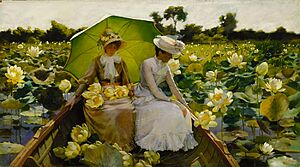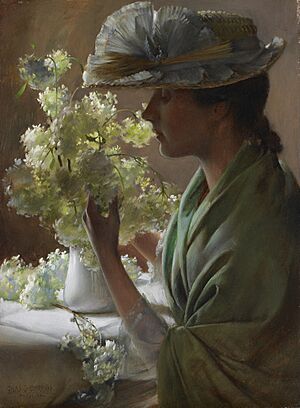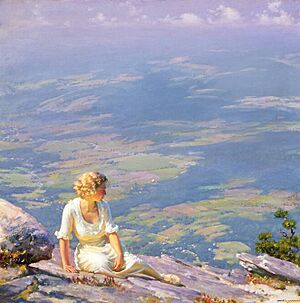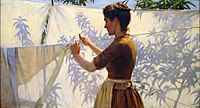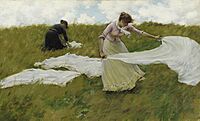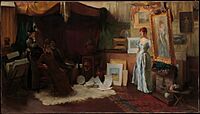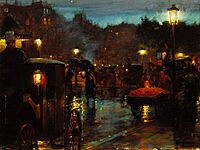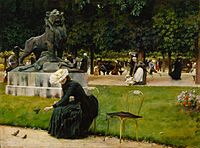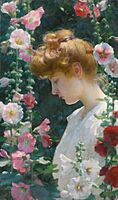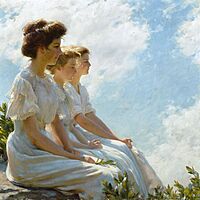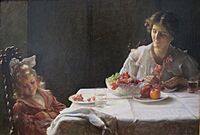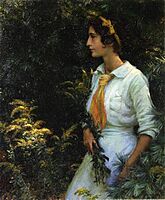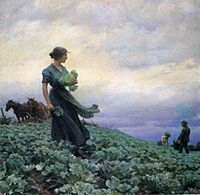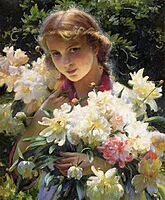Charles Courtney Curran facts for kids
Quick facts for kids
Charles Courtney Curran
|
|
|---|---|
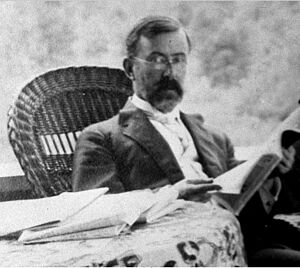
Charles Courtney Curran, around 1909.
|
|
| Born | February 13, 1861 |
| Died | 9 November 1942 (aged 81) |
| Nationality | American |
| Education | National Academy of Design, Académie Julian |
| Known for | Painting |
| Movement | Impressionism |
| Spouse(s) | Grace Wickham Curran |
| Awards | Third Hallgarten Prize (1888) Second Hallgarten Prize (1895) |
Charles Courtney Curran (born February 13, 1861 – died November 9, 1942) was a talented American painter. He is famous for his beautiful paintings of women in different places. He also played a big part in the Cragsmoor Art Colony, a special place where artists gathered.
Contents
Life Story of Charles Courtney Curran
Charles Curran was born in February 1861 in Hartford, Kentucky. His father was a teacher there. A few months later, the American Civil War began. His family moved back to Ohio because of the war. They finally settled in Sandusky, by Lake Erie. His father became a school leader there.
Early Art Studies
Charles showed a strong interest in art from a young age. In 1881, he went to Cincinnati to study at the McMicken School. This school later became the Fine Arts Academy of Cincinnati. He only stayed there for one year.
After that, he moved to New York City. He studied at the National Academy of Design and the Art Students League of New York. He learned from a teacher named Walter Satterlee. Many of his paintings from this time showed young women who worked hard.
Winning an Award and Studying in Paris
One of his paintings, Breezy Day (1887), was very special. It won the Third Hallgarten Prize for Oils in 1888. Soon after, Curran and his wife, Grace, traveled to Paris, France, to study art. Their first child, Louis, was born there.
Returning Home and Cragsmoor
After two and a half years abroad, the family returned to the United States in 1891. For the next ten years, Curran split his time. He had an apartment and studio in New York. He also spent most summers in Ohio, where his family lived.
In 1903, the Currans visited a summer art colony called Cragsmoor, New York. It was in the beautiful Shawangunk Mountains, about 100 miles from New York City. The amazing views and plants inspired Curran. He decided to build a summer home there. He passed away in New York City in 1942.
Charles Curran's Art Career
While in Paris, Curran studied at the Académie Julian. He started to focus on new subjects for his paintings. He also tried out different painting styles. Many of his artworks from this time were painted outdoors. This style is called en plein air. These paintings often showed well-dressed modern women enjoying fun activities.
Paintings in Paris
Two examples from his time in Paris are In the Luxembourg (Garden) (1889) and Afternoon in the Cluny Garden, Paris (1889). Curran also showed three of his paintings at the famous Paris Salons.
Experimenting with Styles
When he painted by Lake Erie, Curran often used his family members as models. He experimented with many art styles. These included impressionism, symbolism, tonalism, and naturalism.
Life and Art at Cragsmoor
After their first visit, the Currans spent their summers at Cragsmoor for the next forty years. Curran created some of his most famous paintings in this area. These artworks often feature young, pretty girls. They are usually dressed in white or light colors and are shown in bright sunshine.
Two examples are On the Heights (1909) and Hilltop Walk (1927). Curran and his wife became very important figures at Cragsmoor. Besides his own art, he taught painting. With his wife's help, he also edited the student art magazine at the colony.
Later Years and Legacy
Curran continued to paint almost until he died. However, he did not adopt the newer art styles that appeared after World War I. He stayed active with many art groups. He was especially involved with the National Academy of Design, where he was a secretary for fifteen years.
After 1920, he also became a successful artist who painted people's portraits. Curran and his wife loved to travel. They visited Europe at least five times. They even traveled to mainland China in 1936.
Famous Works by Charles Courtney Curran
Charles Curran's paintings are in many museum collections. His outdoor paintings of young women are still very popular with art collectors. It is thought that he created over 1500 artworks in his career. These include oil paintings, watercolors, and many illustrations for magazines. Some illustrations were in color, and some were in black and white.
- Charles Courtney Curran
-
A Breezy Day, 1887. Pennsylvania Academy of the Fine Arts
-
Fair Critics, 1887. Metropolitan Museum of Art
-
On the Heights, 1909. Brooklyn Museum
-
Breakfast for Three, 1909. High Museum of Art


